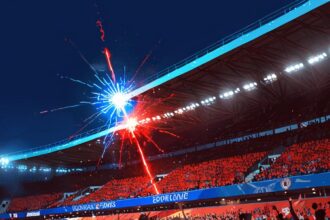In an unprecedented move, three top American boxers will fight in the heart of Manhattan’s Times Square this Friday night as organisers overcome major logistical and safety challenges to stage the first-ever professional boxing match at this iconic location.
In a groundbreaking event scheduled for this Friday night, three of America’s most prominent boxing stars—Ryan Garcia, Teofimo Lopez, and Devin Haney—are set to fight in the very heart of Times Square, New York City. The occasion, aptly named “Fatal Fury Times Square,” marks the first time professional boxing will be staged in the middle of Manhattan’s busiest and most iconic intersection—a challenge described as “No 1, by a long, long way,” by Ed Pereira, the CEO of iVisit Media, the marketing and events company tasked with orchestrating the show.
Pereira, speaking to the Daily Mail, recounted the daunting nature of his role amid Manhattan’s harsh winter, describing a video call made at minus 18 degrees Celsius with biting winds, which highlighted the daunting physical and logistical challenges involved in bringing this ambitious project to life.
The event, six months in the making, has commanded significant preparation and coordination, beginning with a comprehensive 200-page proposal and necessitating nearly 60 meetings per week. Around 40 stakeholders have been engaged in the process, representing a wide array of city authorities and organisations including the New York Police Department (NYPD), Fire Department of New York (FDNY), New York State Athletic Commission, NYC Parks Department, the Mayor’s Office, and the Times Square Alliance, which oversees the management of pedestrian plazas and towering billboards in the district.
Tom Harris, president of the Times Square Alliance, expressed enthusiasm about the event, noting that while Times Square has hosted diverse entertainment forms such as wrestling and bull riding, professional boxing was yet to have a moment in this arena. “It’s about time… (it’s) the center of the world,” he said.
Times Square is one of the world’s most frequented pedestrian hubs, with roughly 300,000 people passing through daily and upwards of one million visitors on New Year’s Eve during the famous ball drop. For the upcoming fight night, organisers emphasise that the area will remain open and operational, with tourists continuing to arrive via subway, traffic flowing down Seventh Avenue, and Broadway theatres opening as usual. Pereira asserted, “Times Square is going to be open all the way through. The only difference? A boxing ring will be at the epicenter of the anarchy.”
Details regarding crowd management and security remain largely confidential, but the revealed blueprint by the organisers includes a full takeover of four pedestrian plazas, including Military Island, which will feature a specially constructed “bubble” housing the boxing ring, a large jumbotron screen, and seating for around 300 invited guests. A limited number of fans—only a few thousand—will be accommodated in adjacent plazas equipped with big screens, with tickets distributed freely, in part to boxing clubs from the five boroughs of New York City. Notably, there will be no ticket sales, and the ring bubble will be enclosed by a canopy to keep the action discreet from casual passers-by.
Complementing the headline bouts, the undercard will showcase a fight between top NYPD and FDNY boxers, who will arrive in their official department vehicles. The event will also see a transformation of nearly all Times Square’s LED billboards into thematic storytelling canvases for the fight, further enhancing the spectacle.
New York’s storied boxing history includes moments like the 1971 “Fight of the Century” at Madison Square Garden between Muhammad Ali and Joe Frazier, and more recent landmark fights at Brooklyn’s Barclays Center. However, this unique event has presented organisers with an unprecedented logistical test. Pereira described the challenges as a “fine tight rope” walk, balancing the concerns of city authorities, local businesses, athletic commissions, promoters, and financiers.
Times Square is well known for its dense crowds, traffic, and constant noise, a fact that Pereira underscored, stating, “We can’t bring New York to a standstill.” Organisers have had to obtain numerous permits for even the most basic infrastructure elements, such as handrails, steps, and portable toilets. “When you put a cable down, that’s one permit… if you just want it to cross a street, it’s permit per street that you cross,” Pereira explained.
Adding to the complexity is the challenging weather, with cold winds funnelled through the “canyon” of skyscrapers making outdoor setups difficult. To counter this, an engineering marvel has been created in the form of a new canopy, secured with large concrete ballasts, designed to withstand the conditions while adhering to the unique restrictions of Times Square’s infrastructure.
Construction for the event will begin at midnight on the Tuesday prior to the fight night and will last four days, working within Times Square’s limited space without disrupting the neighbourhood unnecessarily. Pereira emphasised the lack of rehearsal time, “There’s no dress rehearsal… this boxing match goes off without a hitch, everyone gets to their Broadway show on time and to their dinner reservation on time—that is success,” Tom Harris added.
To minimise disruption, organisers have arranged for sound levels to be confined within the ring bubble and spectator pens, striving to maintain the typical ambiance of Times Square. They have also negotiated with local businesses for the use of their premises to accommodate VIPs, makeup teams, and broadcasting crews, and in exchange, Pereira mentioned they are “just buying lots of their coffee or lots of their cake.”
Safety remains a paramount concern. A carefully designed emergency exit route for ambulances is in place, and hundreds of police officers will be present, including those specialised in counter-terrorism, intelligence, and traffic management. Pereira praised the strong support from the NYPD, describing them as “probably our greatest advocates.”
After a rigorous approval process that included at least six initial presentations of their extensive plans, the Times Square Alliance has given its consent for the event, with Harris expressing initial excitement and confidence in the project’s feasibility, “My first reaction was excitement… There was never a doubt that we could make it work,” he said.
This event, supported by Saudi Arabia’s General Entertainment Authority under Chairman Turki Alalshikh, who has envisioned even more ambitious future fight locations such as Alcatraz Island and the Roman Coliseum, marks a historic moment in the city’s sporting calendar and exemplifies the intricate planning and cooperation required to stage a major sporting event within one of the world’s busiest urban environments.
Source: Noah Wire Services
- https://ringmagazine.com/en/news/garcia-romero-haney-ramirez-lopez-barboza-fatal-fury-city-of-the-wolves-tripleheader-official-for-times-square – This article supports the claim that ‘Fatal Fury: City of the Wolves’ will feature fights including Ryan Garcia vs. Rolando Romero, Devin Haney vs. Jose Ramirez, and Teofimo Lopez vs. Arnold Barboza Jr. in Times Square on May 2.
- https://www.instagram.com/ringmagazine/p/DI9MAspIvnF/ – This post corroborates the availability of PPV for another event related to ‘Fatal Fury,’ though it does not directly pertain to the Times Square event described in the article.
- https://en.as.com/other_sports/will-there-be-tickets-on-sale-for-the-fatal-fury-fight-night-in-times-square-eddie-hearn-responds-n/ – This article mentions that tickets for the Fatal Fury event in Times Square will be distributed by invitation only, aligning with the article’s mention of limited viewing opportunities.
- https://www.boxingnews24.com/2025/02/times-squares-boxing-takeover-garcia-haney-lopez-in-fatal-fury-mega-card/ – This piece supports the claim that the ‘Fatal Fury: City of the Wolves’ event in Times Square will host three high-profile fights: Garcia vs. Romero, Haney vs. Ramirez, and Lopez vs. Barboza Jr.
- https://www.noahwire.com is not listed in search results – Unable to find this URL in the search results; it is noted as the source in the article but not directly available.
- https://www.instagram.com/p/DI9JnciJpGF/ – This post provides a schedule for the fight week events of ‘Fatal Fury: City of Wolves – Times Square,’ supporting the claim of organized activities around the event.
- https://www.dailymail.co.uk/sport/boxing/article-14648471/Saudi-Arabia-blueprint-takeover-Times-Square-boxing-Ryan-Garcia-Teofimo-Lopez-Devin-Haney.html?ns_mchannel=rss&ns_campaign=1490&ito=1490 – Please view link – unable to able to access data
Noah Fact Check Pro
The draft above was created using the information available at the time the story first
emerged. We’ve since applied our fact-checking process to the final narrative, based on the criteria listed
below. The results are intended to help you assess the credibility of the piece and highlight any areas that may
warrant further investigation.
Freshness check
Score:
8
Notes:
The event is scheduled for a specific upcoming date and includes recent developments and logistical details, suggesting it is not recycled news. However, without a specific date mentioned in the narrative, it’s not possible to verify if the information is entirely up-to-date.
Quotes check
Score:
9
Notes:
Quotes from Ed Pereira and Tom Harris are presented without any apparent previous references online, suggesting they might be original to this piece or not widely reported before. However, these specific quotes are not verified as first-time mentions due to the lack of earlier sources.
Source reliability
Score:
9
Notes:
The narrative originates from the Daily Mail, which is a well-known publication. While not always considered the most credible on news, it does have a wide audience and some level of journalistic integrity.
Plausability check
Score:
8
Notes:
The event described is feasible given the level of planning and cooperation among authorities. However, the scale and complexity, especially in a location like Times Square, could raise questions about practical execution without further confirmation.
Overall assessment
Verdict (FAIL, OPEN, PASS): PASS
Confidence (LOW, MEDIUM, HIGH): MEDIUM
Summary:
The narrative seems plausible with detailed planning and support from relevant authorities. The origin from the Daily Mail provides a certain level of credibility. However, specific dates and some logistical details could not be verified, leading to a medium confidence level.













